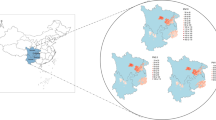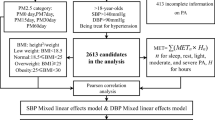Abstract
The trade-off between the potentially detrimental effects of fine particulate matter (PM2.5) and the benefits of physical activity (PA) is unclear. We aimed to explore the independent and interaction effects between long-term PM2.5 exposure and PA on blood pressure (BP) and hypertension. A total of 8704 adults (≥45 years) without hypertension at baseline in a nationwide cohort of the China Health and Retirement Longitudinal Study (CHARLS) were followed from 2011 to 2015. The participants were selected using a four-stage, stratified, and cluster sampling procedure. The annual PM2.5 concentrations at the residential address were estimated from a two-stage machine learning model with a 10 km × 10 km resolution. A standard questionnaire collected information on PA and potential confounders, and metabolic equivalents (MET·h/wk), which combined frequency, intensity, and duration information, were used to assess PA levels. We adopted mixed-effects regression models to explore the independent and interaction effects between long-term PM2.5 exposure and PA on BP and risk of hypertension. Systolic blood pressure (SBP) decreased by −0.84 mmHg (95% CI: −1.34, −0.34) per an IQR (interquartile range, 175.5 MET·h/wk) increase in PA, and diastolic blood pressure (DBP) decreased by −0.42 mmHg (95% CI: −0.76, −0.07). Each IQR (36.1 μg/m3) increment in PM2.5 was associated with 0.48 mmHg (95% CI: −0.24, 1.20) in SBP and −0.02 mmHg (95% CI: −0.44, 0.39) in DBP. PM2.5 showed an elevated effect with risks of hypertension (odds ratio, OR = 1.01; 95% CI: 1.00, 1.03), while PA showed the inverse result (OR = 0.98; 95% CI: 0.97, 0.99). Interaction analyses indicated PA maintained the beneficial effects on BP, but the negative association was attenuated, accompanied by the increase of PM2.5. PA decreased the BP and hypertension risks, while PM2.5 showed the opposite results. PM2.5 attenuated the beneficial effects of PA on BP and modified the association between PA and the risk of hypertension.



Similar content being viewed by others
Data availability
The authors declare that the data and materials will be available to readers upon request.
References
Ainsworth BE, Haskell WL, Whitt MC et al (2000) Compendium of physical activities: an update of activity codes and MET intensities. Med Sci Sports Exerc 32:S498–S516. https://doi.org/10.1097/00005768-200009001-00009
Ainsworth BE, Haskell WL, Herrmann SD et al (2011) 2011 Compendium of physical activities: a second update of codes and MET values. Med Sci Sports Exerc 43(8). https://doi.org/10.1249/MSS.0b013e31821ece12
An R, Kang H, Cao L et al (2020) Engagement in outdoor physical activity under ambient fine particulate matter pollution: a risk-benefit analysis. J Sport Health Sci 11:S2095–S2546. https://doi.org/10.1016/j.jshs.2020.09.008
Andersen ZJ, de Nazelle A, Mendez MA et al (2015) A study of the combined effects of physical activity and air pollution on mortality in elderly urban residents: the Danish diet, cancer, and health cohort. Environ Health Perspect 123(6):557–563. https://doi.org/10.1289/ehp.1408698
Avila-Palencia I, Laeremans M, Hoffmann B et al (2019) Effects of physical activity and air pollution on blood pressure. Environ Res 173:387–396. https://doi.org/10.1016/j.envres.2019.03.032
Bo Y, Guo C, Lin C et al (2019) Dynamic changes in long-term exposure to ambient particulate matter and incidence of hypertension in adults: a natural experiment. Hypertension 74(3):669–677. https://doi.org/10.1161/HYPERTENSIONAHA.119.13212
Brook RD, Urch B, Dvonch JT et al (2009) Insights into the mechanisms and mediators of the effects of air pollution exposure on blood pressure and vascular function in healthy humans. Hypertension 54(3):659–667. https://doi.org/10.1161/HYPERTENSIONAHA.109.130237
Cai Y, Zhang B, Ke W et al (2016) Associations of short-term and long-term exposure to ambient air pollutants with hypertension: a systematic review and meta-analysis. Hypertension 68(1):62–70. https://doi.org/10.1161/HYPERTENSIONAHA.116.07218
Cohen L, Curhan GC, Forman JP (2012) Influence of age on the association between lifestyle factors and risk of hypertension. J Am Soc Hypertens 6(4):284–290. https://doi.org/10.1016/j.jash.2012.06.002
Craig CL, Marshall AL, Sjostrom M et al (2003) International physical activity questionnaire: 12-country reliability and validity. Med Sci Sports Exerc 35(8):1381–1395. https://doi.org/10.1249/01.MSS.0000078924.61453.FB
Committee of healthy China initiative (2019) Healthy China initiative (2019-2030). National health commission of the People’s Republic of China. Available at: http://www.gov.cn/xinwen/2019-07/15/content_5409694.htm?utm_source=UfqiNews.
Daigle CC, Chalupa DC, Gibb FR et al (2003) Ultrafine particle deposition in humans during rest and exercise. Inhal Toxicol 15(6):539–552. https://doi.org/10.1080/08958370304468
DeFlorio-Barker S, Lobdell DT, Stone SL et al (2020) Acute effects of short-term exposure to air pollution while being physically active, the potential for modification: a review of the literature. Prev Med 139:106195. https://doi.org/10.1016/j.ypmed.2020.106195
Dong GH, Qian Z, Xaverius PK et al (2013) Association between long-term air pollution and increased blood pressure and hypertension in China. Hypertension 61(3):578–584. https://doi.org/10.1161/HYPERTENSIONAHA.111.00003
Elliott EG, Laden F, James P et al (2020) Interaction between long-term exposure to fine particulate matter and physical activity, and risk of cardiovascular disease and overall mortality in US women. Enviro Health Perspect 128(12):127012. https://doi.org/10.1289/EHP7402
Foulds HJA (2017) High volume physical activity and cardiovascular risks. Am J Hypertens 30(4):353–354. https://doi.org/10.1093/ajh/hpx009
Geng G, Xiao Q, Liu S et al (2021) Tracking air pollution in China: near real-time PM2.5 retrievals from multisource data fusion. Environ Sci Technol 55(17):12106–12115. https://doi.org/10.1021/acs.est.1c01863
Guo C, Zeng Y, Chang L et al (2020) Independent and opposing associations of habitual exercise and chronic PM 2.5 exposures on hypertension incidence. Circulation 142(7):645–656. https://doi.org/10.1161/CIRCULATIONAHA.120.045915
Guo Q, Zhao Y, Shao J et al (2021) Using heart rate to estimate the minute ventilation and inhaled load of air pollutants. Sci Total Environ 763:143011. https://doi.org/10.1016/j.scitotenv.2020.143011
Huai P, Xun H, Reilly KH et al (2013) Physical activity and risk of hypertension: a meta-analysis of prospective cohort studies. Hypertension 62(6):1021–1026. https://doi.org/10.1161/HYPERTENSIONAHA.113.01965
Int Panis L, de Geus B, Vandenbulcke G et al (2010) Exposure to particulate matter in traffic: a comparison of cyclists and car passengers. Atmos Environ 44(19):2263–2270. https://doi.org/10.1016/j.atmosenv.2010.04.028
Joseph P, Leong D, McKee M et al (2017) Reducing the global burden of cardiovascular disease, Part 1. Circ Res 121(6):18. https://doi.org/10.1161/circresaha.117.308903
Kocot K, Zejda JE (2021) Acute cardiorespiratory response to ambient air pollution exposure during short-term physical exercise in young males. Environ Res 195:110746. https://doi.org/10.1016/j.envres.2021.110746
Korshøj M, Krause N, Clays E et al (2017) Does aerobic exercise increase 24-hour ambulatory blood pressure among workers with high occupational physical activity?—A RCT. Am J Hypertens 30(4):444–450. https://doi.org/10.1093/ajh/hpw197
Krause N, Brand RJ, Kaplan GA et al (2007) Occupational physical activity, energy expenditure and 11-year progression of carotid atherosclerosis. Scand J Work, Environ Health 33(6):405–424. https://doi.org/10.5271/sjweh.1171
Kubesch NJ, Therming Jørgensen J, Hoffmann B et al (2018) Effects of leisure-time and transport-related physical activities on the risk of incident and recurrent myocardial infarction and interaction with traffic-related air pollution: a cohort study. J Am Heart Assoc 7(15). https://doi.org/10.1161/JAHA.118.009554
Lee PH, Macfarlane DJ, Lam T et al (2011) Validity of the international physical activity questionnaire short form (IPAQ-SF): a systematic review. Int J Behav Nutr Phys Act 8(1):115. https://doi.org/10.1186/1479-5868-8-115
Li N, Chen G, Liu F et al (2020) Associations between long-term exposure to air pollution and blood pressure and effect modifications by behavioral factors. Environ Res 182:109109. https://doi.org/10.1016/j.envres.2019.109109
Li S, Liu Z, Joseph P et al (2022) Modifiable risk factors associated with cardiovascular disease and mortality in China: a PURE substudy. Eur Heart J. https://doi.org/10.1093/eurheartj/ehac268
Lin H, Guo Y, Zheng Y et al (2017) Long-term effects of ambient PM2.5 on hypertension and blood pressure and attributable risk among older Chinese adults. Hypertension 69(5):806–812. https://doi.org/10.1161/HYPERTENSIONAHA.116.08839
Liu C, Chen R, Zhao Y et al (2017a) Associations between ambient fine particulate air pollution and hypertension: a nationwide cross-sectional study in China. Sci Total Environ 584:869–874. https://doi.org/10.1016/j.scitotenv.2017.01.133
Liu X, Zhang D, Liu Y et al (2017b) Dose–response association between physical activity and incident hypertension: a systematic review and meta-analysis of cohort studies. Hypertension 69(5):813–820. https://doi.org/10.1161/HYPERTENSIONAHA.116.08994
Liu Q, Huang K, Liang F et al (2022) Long-term exposure to fine particulate matter modifies the association between physical activity and hypertension incidence. J Sport Health Sci 11:900019. https://doi.org/10.1016/j.jshs.2022.01.004
Ministry of Environmental Protection of the People’s Republic of China (2016) Ambient air quality standards. GB 3095-2012. Ministry of Environmental Protection of the People’s Republic of China. Available at: https://www.mee.gov.cn/ywgz/fgbz/bz/bzwb/dqhjbh/dqhjzlbz/201203/t20120302_224165.shtml. Accessed 14 Nov 2022
Murray CJL, Aravkin AY, Zheng P et al (2020) Global burden of 87 risk factors in 204 countries and territories, 1990-2019: a systematic analysis for the Global Burden of Disease Study 2019. Lancet 396(10258):1223–1249. https://doi.org/10.1016/S0140-6736(20)30752-2
Sacks JD, Stanek LW, Luben TJ et al (2011) Particulate matter–induced health effects: who is susceptible? Environ Health Perspect 119(4):446–454. https://doi.org/10.1289/ehp.1002255
Sinharay R, Gong J, Barratt B et al (2018) Respiratory and cardiovascular responses to walking down a traffic-polluted road compared with walking in a traffic-free area in participants aged 60 years and older with chronic lung or heart disease and age-matched healthy controls: a randomised, crossover study. Lancet 391(10118):339–349. https://doi.org/10.1016/S0140-6736(17)32643-0
Stieb DM, Shutt R, Kauri LM et al (2018) Cardiorespiratory effects of air pollution in a panel study of winter outdoor physical activity in older adults. J Occup Enviro Med 60(8):673–682. https://doi.org/10.1097/JOM.0000000000001334
Strak M, Boogaard H, Meliefste K et al (2010) Respiratory health effects of ultrafine and fine particle exposure in cyclists. Occup Environ Med 67(2):118–124. https://doi.org/10.1136/oem.2009.046847
World Health Organization (2021) Hypertension in China. Available at: https://www.who.int/china/zh/health-topics/hypertension. Accessed 14 Nov 2022
Writing Group of 2018 Chinese Guidelines for the Management of Hypertension, Chinese Hypertension League, Chinese Society of Cardiology et al (2019) 2018 Chinese guidelines for the management of hypertension. Chin J Cardiovasc Med 24(1–46):46. https://doi.org/10.3969/j.issn.1672-5301.2019.03.001
Xie X, Wang Y, Yang Y et al (2018) Long-term effects of ambient particulate matter (with an aerodynamic diameter ≤2.5 μm) on hypertension and blood pressure and attributable risk among reproductive-age adults in China. J Am Heart Assoc 7(9). https://doi.org/10.1161/JAHA.118.008553
Xiao Q, Geng G, Cheng J et al (2021a) Evaluation of gap-filling approaches in satellite-based daily PM2.5 prediction models. Atmos Enviro 244:117921. https://doi.org/10.1016/j.atmosenv.2020.117921
Xiao Q, Zheng Y, Geng G et al (2021b) Separating emission and meteorological contributions to long-term PM2.5 trends over eastern China during 2000–2018. Atmos Chem Physics 21(12):9475–9496. https://doi.org/10.5194/acp-21-9475-2021
Yang B-Y, Qian Z, Howard SW et al (2018) Global association between ambient air pollution and blood pressure: a systematic review and meta-analysis. Environ Pollut 235:576–588. https://doi.org/10.1016/j.envpol.2018.01.001
Zhang Z, Laden F, Forman JP et al (2016) Long-term exposure to particulate matter and self-reported hypertension: a prospective analysis in the Nurses’ Health Study. Environ Health Perspect 124(9):1414–1420. https://doi.org/10.1289/EHP163
Zhang Z, Guo C, Lau AKH et al (2018a) Long-term exposure to fine particulate matter, blood pressure, and incident hypertension in Taiwanese adults. Enviro Health Perspect 126(1):017008. https://doi.org/10.1289/EHP2466
Zhang Z, Hoek G, Chang L et al (2018b) Particulate matter air pollution, physical activity and systemic inflammation in Taiwanese adults. Int J Hyg Environ Health 221(1):41–47. https://doi.org/10.1016/j.ijheh.2017.10.001
Zhang Z, Dong B, Li S et al (2019) Exposure to ambient particulate matter air pollution, blood pressure and hypertension in children and adolescents: a national cross-sectional study in China. Environ Int 128:103–108. https://doi.org/10.1016/j.envint.2019.04.036
Zhao Y, Hu Y, Smith JP et al (2014) Cohort profile: the China Health and Retirement Longitudinal Study (CHARLS). Int J Epidemiol 43(1):61–68. https://doi.org/10.1093/ije/dys203
Zhou M, Wang H, Zeng X et al (2019) Mortality, morbidity, and risk factors in China and its provinces, 1990-2017: a systematic analysis for the Global Burden of Disease Study 2017. Lancet 394(10204):1145–1158. https://doi.org/10.1016/S0140-6736(19)30427-1
Acknowledgements
We would like to thank all the staff and participants of the CHARLS team for collecting data and assisting with data access for this study. We would like to thank the TAP team for their support in providing PM2.5 data.
Author information
Authors and Affiliations
Contributions
Yuchen Zhao: formal analysis, methodology, visualization, writing – original draft. Qian Guo: data curation, methodology, validation, writing – review and editing. Jiahao Zhao: methodology, validation. Liqianxin Qian: methodology, validation. Mengyao Bian: validation, writing – review and editing. Jing Shao: methodology, writing – review and editing. Qirong Wang: methodology, writing – review and editing. Xiaoli Duan: conceptualization, methodology, data curation, writing – review and editing, supervision.All authors have read and approved the final version of the manuscript and agreed with the order of presentation of the authors.
Corresponding author
Ethics declarations
Ethical approval
The ethics review committee of Peking University approved the CHARLS project (IRB00001052–11015).
Consent to participate
Written informed consent was provided by all participants.
Consent for publication
All authors agree with publication in this journal.
Competing interests
The authors declare no competing interests.
Additional information
Responsible Editor: Lotfi Aleya
Publisher’s note
Springer Nature remains neutral with regard to jurisdictional claims in published maps and institutional affiliations.
Supplementary Information
Rights and permissions
Springer Nature or its licensor (e.g. a society or other partner) holds exclusive rights to this article under a publishing agreement with the author(s) or other rightsholder(s); author self-archiving of the accepted manuscript version of this article is solely governed by the terms of such publishing agreement and applicable law.
About this article
Cite this article
Zhao, Y., Guo, Q., Zhao, J. et al. Long-term exposure to fine particulate matter modifies the association between physical activity and the risk of hypertension. Environ Sci Pollut Res 30, 43690–43701 (2023). https://doi.org/10.1007/s11356-023-25256-6
Received:
Accepted:
Published:
Issue Date:
DOI: https://doi.org/10.1007/s11356-023-25256-6




